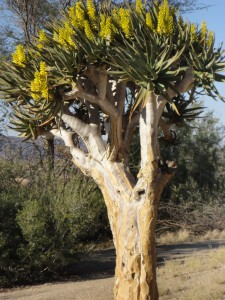The Quiver Tree is probably the most spectacular aloe species that is found in South Africa because of its sculptural form. Aloe dichotoma, also known as Quiver tree or Kokerboom (Afrikaans), is a species of aloe indigenous to Southern Africa.

Quiver Tree in the Augrabies Falls National Park.
Quiver Trees are specifically found in the Northern Cape Richtersveld region and the Namib desert around the South African-Namibian border. Known as Choje to the indigenous San people, the Quiver tree gets its name from the San practice of hollowing out the tubular branches to form quivers for their arrows.
The thick succulent leaves of the Quiver tree grows in a rosette, but up to 6 meter in the air to escape the worst of the devastating heat; each at the end of a stumpy branch. The branches are thickly covered in a fine white powder to help in keeping cool for it reflects the sun’s heat instead of absorbing it. The branches and trunk are filled with a soft fibre that can hold a great quantity of water.
There are 3 quiver tree species in South Africa – the more widespread Aloe dichotoma, the shrub-like maiden aloe (Aloe ramosissima) and the critically endangered Aloe pillansii, also called the giant quiver tree.
The giant quiver tree is classified as critically endangered. It occurs in a narrow band and its southernmost range is well above the Tropic of Capricorn. Their numbers have diminished steadily, in part because of goats and plant collectors, and also because climatic conditions have affected seedling growth.
Where can you see them?
The widespread Aloe dichotoma can be viewed in the Northern Cape near Upington and within the Augrabies Falls National Park. Also at Worcester, about 80km from Cape Town in the Karoo Desert National Botanical Gardens.
The giant quiver tree can be viewed in the Ai-Ais Richtersveld Transfrontier Park which stretches from South Africa into Namibia. You can also stay in the National Park, which offers camping as well as self-catering chalets.
Please note you’ll you’ll need a 4×4 or high-clearance vehicle and take care, the region where the giant aloe is found, can be extremely hot.
Sources
South Africa Tourism




